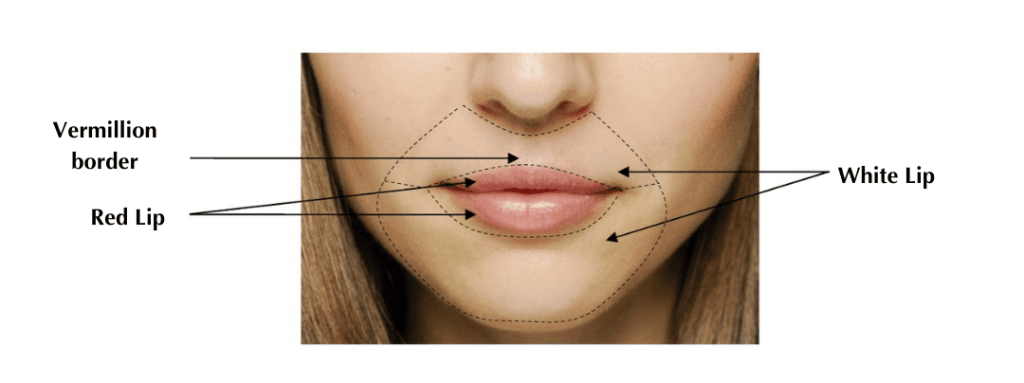Skin on the face is particularly exposed and stimulated, which is why skin aging is often most visible there. Wrinkles and fine lines are the main visible markers of this skin aging phenomenon. They start to become visible at the age of 25 and progressively expand and deepen until menopause, a time when hormones decline and the process speeds up.
The wrinkles are 100 micrometres to several millimetres deep. They are linear ridges in the skin that are visible to the naked eye; they are bound by two edges forming a “rim” and are generally bilateral and symmetric.


When observed under a microscope, the skin is not completely smooth and even. In fact, it has folds of varying sizes and forms a grid of sorts. With age, the largest folds deepen while the smallest folds are reduced until they completely disappear. These phenomena disrupt the established grid, giving rise to visible wrinkles.
There are two types of wrinkles:


All of the internal and external factors generating aging mechanisms will cause structural, functional and morphological changes to the skin that lead to wrinkle formation.
– Elastin fibers that give the skin elasticity and tone
– Collagen fibers that give the skin solidity and resistance
In the dermis, the decreasing size and number of fibroblasts leads to the reorganization of the dermal architecture. Thus, altered dermal elastin fibers lead to loss of suppleness, firmness and elastase-induced superficial atrophy. From the age of 20, each woman loses 1 percent of her collagen each year, on average. Collagen fibers break and become scarcer with age. They degrade and no longer correctly play their role as skin support.
– Type I collagen predominates as the fibers become more rigid and less supple. Sclerosis becomes apparent, characterized by loss of skin firmness.
– Type III collagen production declines and collagenase destroys fibers.
– Glycation: a chemical process that bonds excess sugars in the body to collagen fibers. These fibers become rigid and then clump together, losing their suppleness and tearing off. Wrinkles appear and the skin sags. In addition, enzymes that normally prevent glycation in young skin no longer fulfill their role.
=> more information on the sun and the skin
The movements generated by contracting subcutaneous muscles create tension that modifies the dermis and promotes the formation of expression wrinkles. Around 30 muscles are involved in facial expression and control the movements induced by our expressions (smiling, frowning, grimacing, etc.). Every day, around 15,000 movements of the facial muscles generate tension that reaches the dermis, causing wrinkles and fine lines to appear. Some areas of the face, such as the forehead, eyes, nose and lips, are strained more than others and are then prematurely marked.
– The epidermis in the eye contour area is almost devoid of sebum and the hydrolipidic film that covers it is therefore deficient. Its thickness is reduced to 0.33 to 0.36 mm compared with 1 to 1.6 mm for the rest of the face.
– The dermis in the eye contour area lacks sebaceous and sweat glands but is well vascularized. It does not have many support fibers (collagen and elastin), which makes it particularly sensitive to sagging. It is only 0.5mm thick whereas it is 1 to 2 mm thick over the rest of the face.
– The hypodermis, or subcutaneous tissue, in the eye contour area does not contain many adipose cells and is easily distended.
Lacking in collagen, elastin and adipose cells, the eye contour area is prone to dryness. Continuous muscle movements deteriorate the fibers more rapidly, which become less firm, therefore causing the skin to sag, which is often the first sign of aging.
The eye contour is an area particularly sensitive to aging. It is so fragile that it lacks resistance against external attacks such as pollution, gravity or solar rays. The eye contour area tends to age prematurely. With time, the elastic fibers and collagen fibers alter, which results in the sagging and a deterioration of the lower eyelid. In addition, early signs of fine lines appear around the sensitive area of the eyes: the first expression lines take shape at the outer corner of the eye and form “crow’s feet.”


=> Biologique Recherche eye care protocol
– The red lip: the mucous part.
– The vermilion border: the separation between the red and white lips. This is a genuine arch supporting the architecture of the lips.
– The white lip: the lip contour. The upper lip starts at the end of the nose and extends to the vermilion border. The lower lip starts just above the chin.


Red lips age first by sagging and then becoming thinner. They successively suffer from dehydration, loss of volume and loss of tone until they can no longer effectively fulfill their support function. The vermilion border progressively becomes fragile and ultimately loses its strength, resulting in a loss of relief and structure, as wrinkles progressively appear on the lip contour. White lips are affected by the appearance of vertical wrinkles: the “sun crease” wrinkles. The weakening of the dehydrated red lips and loss of tone of the vermilion border undermine the white lips. An increasing number of small fine lines appear, followed by wrinkles, becoming deeper and deeper, on the lip contour.
Depending on your Skin Instants©, Biologique Recherche has many options to treat wrinkles and fine lines.
As there are many different types and causes of lines and fine lines we invite you to contact your nearest Biologique Recherche centre for a skin diagnosis by using the Biologique Recherche diagnostic tools: the Skin Instant Lab and/or the Visiolab.
=> Book now your Skin diagnosis at The Beauty Embassy